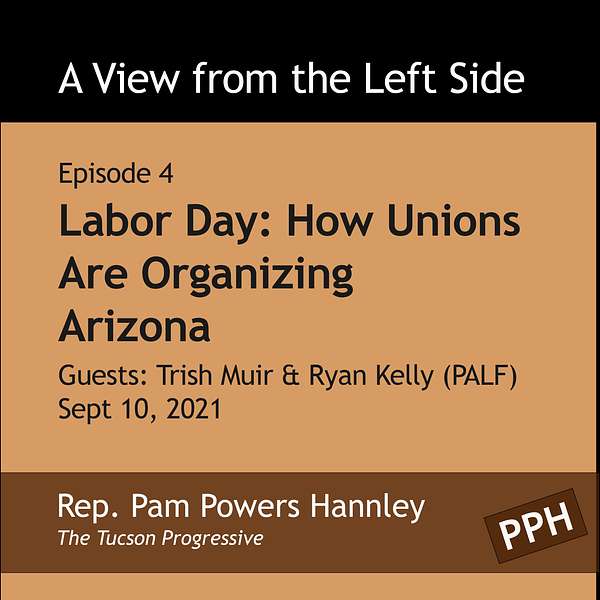
A View from the Left Side
A View from the Left side is hosted by Pamela Powers, progressive author and former member of the Arizona Legislature. Powers and her guests tackle wide-ranging topics from politics and policy to health and wellness, lifestyle, technology and culture.
A View from the Left Side
Labor Day: How Unions Are Organizing Arizona
Work has changed dramatically in the past 40 years.
In the 1980s, President Reagan busted the air traffic controllers’ union, corporations began closing factories and offshoring American jobs to countries with cheap labor, and trickledown economics dictated tax cuts for the rich and the dregs for the rest of us.
It the 1990s, banking deregulation paved the way for the Wall Street crash of 2008 by eliminating financial protections enacted after the Great Depression.
During the Great Recession, which dragged on for years, almost 9 million Americans lost their jobs. Unemployment hit its peak at 10% in 2009. Although, many governors tout robust recoveries from the 2008 Wall Street crash, the jobs Americans have today are dramatically different from jobs in the 1970s – before union busting, offshoring, and tax cuts for the rich became commonplace. Before politicians cared more about fundraising and getting elected, than about the people they claim to serve.
In an episode of his podcast “Marketplace,” NPR’s Kai Ryssdal said, in 2018, “Today is a much different picture. Unemployment is near its lowest level in 50 years. On paper, the American labor force has more than recovered, but when you dig a little deeper, the imprint of the financial crisis is visible in the types of work people now do and how they get paid for it.”
Entry level pay for college graduates increased only 6% in six decades (1960-2018), although housing, healthcare and college debt have increased exponentially.
Most of the jobs created in the decade after the 2008 Wall Street Crash were alternative work, according to NPR, temporary, on-call, contract, or freelance work. In a decade, the work/life norm in the United States shifted from fulltime work with decent wages, benefits and maybe even a union card to just-in-time labor and juggling multiple jobs and daycare in the gig economy.
In this pre-COVID time period, one in three US adults reported doing some type of nonstandard, “gig economy” work to make ends meet. In 2018, participation in the labor force was 63%, a record low. Pre-COVID, the gig economy was pervasive in Tucson. So many people worked as ride-share drivers and/or delivered packages in their personal cars. I often wondered how many of them had careers and fulltime work before the crash.
When COVID hit in 2020, there was another wave of job losses and more dramatic changes to work life.
In March 2021, the Economic Policy Institute reported that although the US economy had been adding jobs, particularly as the vaccinations rolled out, the US was still down 9.5 million jobs compared to pre-pandemic levels one year earlier. At this rate, they estimated it would take two years to get back to February 2020 employment levels. This prediction was made before the Delta variant caused another wave of the pandemic in 2021. When factoring in the number of jobs that weren’t created during the COVID economic slowdown, EPI says more than 25 million American workers were “directly harmed by the COVID labor market.”
As I said in one of my 2020 pandemic videos, many jobs and industries may become obsolete or may be changed forever. The continuation of pandemic era consumer hesitancy toward large crowds, big indoor events, air travel and in-person shopping could stall economic recovery into the future. The steady stream of misinformation about vaccines and masks has given the COVID19 Delta Variant the freedom to infect and kill thousands of people unnecessarily.
In my opinion, now more than ever, people need the protections that unions provide.
In honor of Labor day, my guests today are Trish Muir, who is Chair of the Pima Area Labor Federation and a member of the Teamsters union, and Ryan Kelly, who is the PALF field director and a member of the National Writers’ Union, which is also my union.